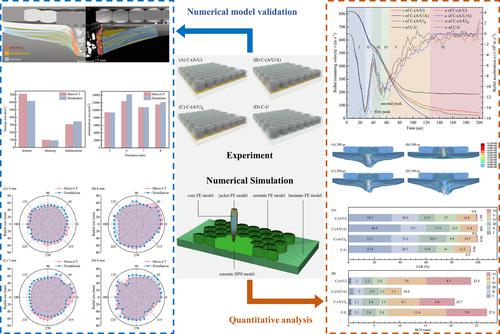当前位置:
X-MOL 学术
›
Polym. Compos.
›
论文详情
Our official English website, www.x-mol.net, welcomes your feedback! (Note: you will need to create a separate account there.)
Quantitative investigation on ballistic resistance and energy absorption behavior of columnar ceramic/interlayer hybrid fiber composites
Polymer Composites ( IF 5.2 ) Pub Date : 2024-03-13 , DOI: 10.1002/pc.28300 Yang Jiang 1 , Zhongwei Zhang 1 , Chunming Song 1 , Yizhong Tan 1 , Yuan Lin 1 , Yuhang Xiang 2 , Minqian Sun 1
−1 and 16.6 mm, respectively. During the penetration process, the ceramic/fiber composites mainly exhibited damage failure mechanisms such as ceramic crushing to form ceramic cones, shear failure, and shear‐tensile‐delamination mixed failure. The energy absorption rate (EAR) of ceramic failure was 54.1%–60.2%, the EAR of tension was 12.5%–20.9%, and the EAR of the tension‐delamination‐shearing mixed model was 21.9%–32.8%.Highlights The numerical model is quantitatively validated with micro‐CT results. Ballistic resistance and EARs in six stages are quantitatively analyzed. C‐(A/U/A) composite has superior ballistic resistance compared to C‐U.
中文翻译:

柱状陶瓷/层间混合纤维复合材料防弹性能和能量吸收行为的定量研究
本文研究了混合纤维结构对柱状陶瓷/层间混合纤维复合材料弹道性能的影响。制备了三种混合纤维复合材料和一种单纤维复合材料。通过对显微 CT 图像与模拟结果的匹配进行定量分析,验证了数值模型的准确性。数值模拟与显微CT的后凸高度(BCH)值的误差仅为2.8%。四个厚度位置的分层面积误差分别仅为0.7%、14.7%、0.3%和5.3%。对陶瓷/纤维复合材料防弹性能的定量研究表明,所有混合纤维复合材料都具有增强的抗穿透性,其中夹层结构的性能优于其他复合材料。与C-U样品相比,C-(A/U/A)样品中子弹的剩余速度和BCH都有显着提高,降低了195 m∙s−1 分别为 16.6 毫米和 16.6 毫米。在渗透过程中,陶瓷/纤维复合材料主要表现出陶瓷破碎形成陶瓷锥体、剪切破坏和剪切-拉伸-分层混合破坏等损伤破坏机制。陶瓷失效的能量吸收率(EAR)为54.1%~60.2%,拉伸的EAR为12.5%~20.9%,拉伸-分层-剪切混合模型的EAR为21.9%~32.8%。 该数值模型通过显微 CT 结果进行了定量验证。 对六个阶段的弹道阻力和 EAR 进行了定量分析。 与 C-U 相比,C-(A/U/A) 复合材料具有优异的防弹性能。
更新日期:2024-03-13
Polymer Composites ( IF 5.2 ) Pub Date : 2024-03-13 , DOI: 10.1002/pc.28300 Yang Jiang 1 , Zhongwei Zhang 1 , Chunming Song 1 , Yizhong Tan 1 , Yuan Lin 1 , Yuhang Xiang 2 , Minqian Sun 1
Affiliation

|
中文翻译:

柱状陶瓷/层间混合纤维复合材料防弹性能和能量吸收行为的定量研究



























 京公网安备 11010802027423号
京公网安备 11010802027423号